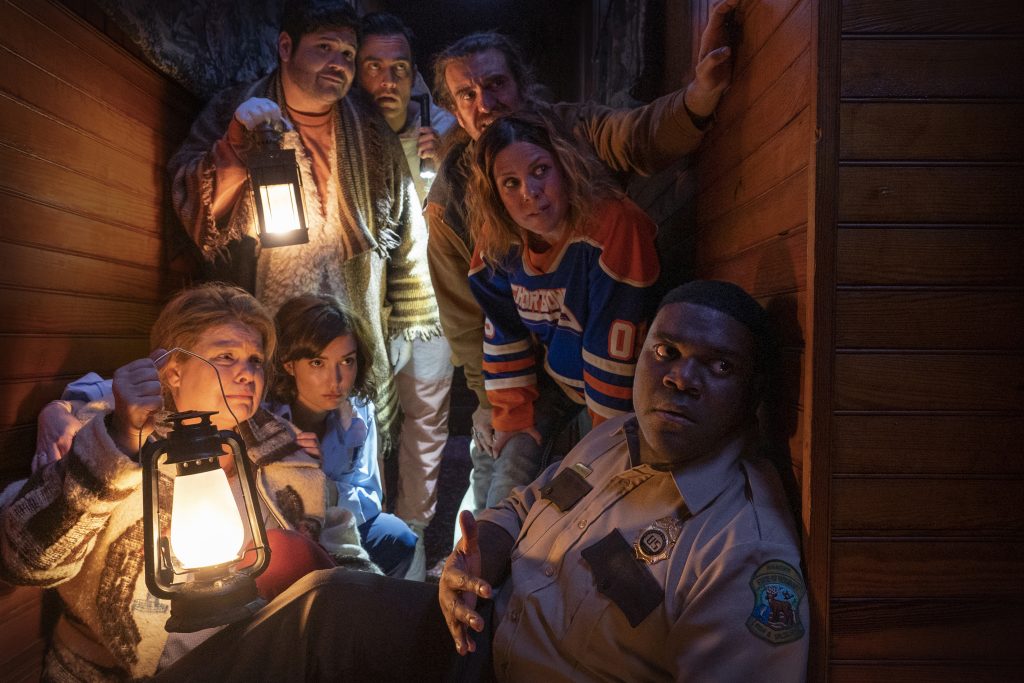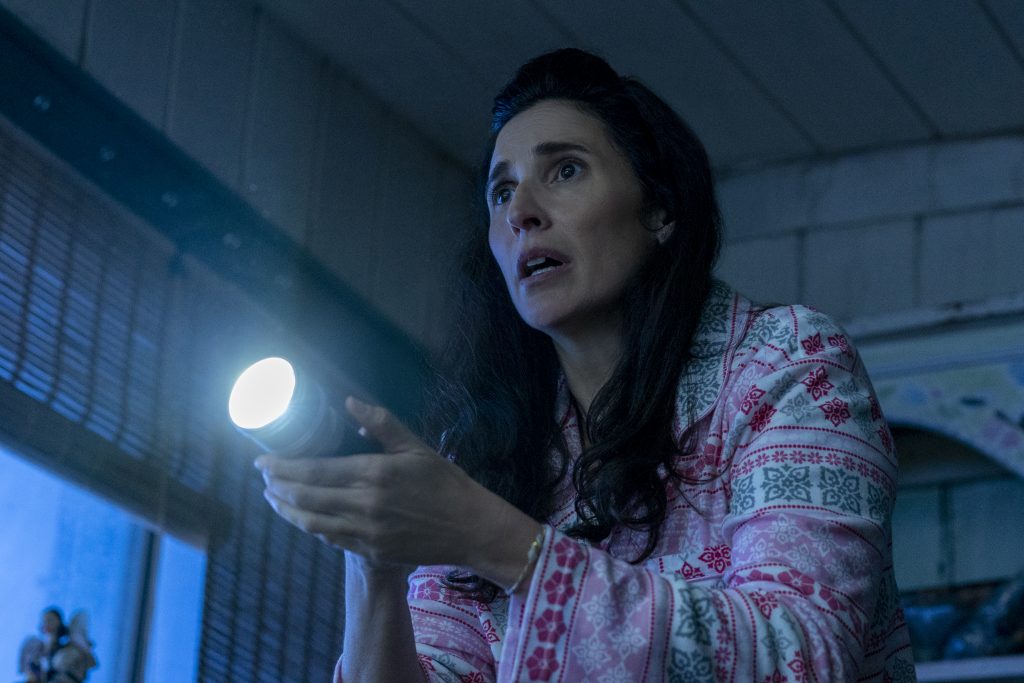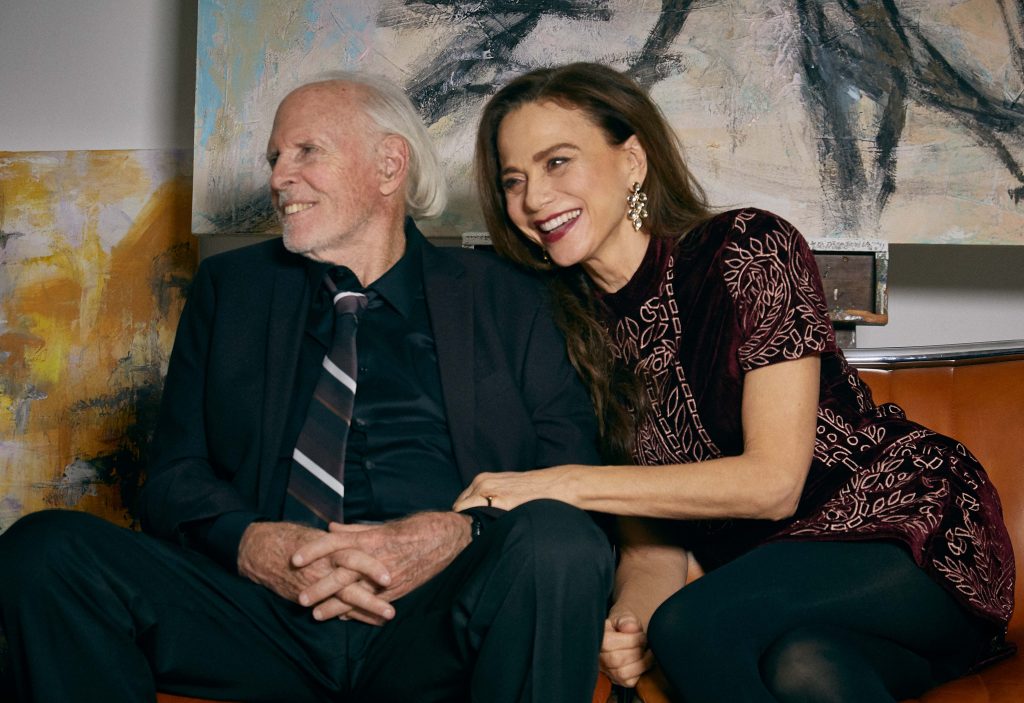February 18, 2022
by Carla Hay

Directed by Aimee Long
Some language in Mandarin with subtitles
Culture Representation: Taking place in New York City, the dramatic film “A Shot Through the Wall” features a racially diverse cast (Asian and white, with some African Americans and Latinos) representing the working-class and middle-class.
Culture Clash: A Chinese American police officer accidentally shoots and kills an unarmed and innocent black man through an apartment building wall, and he becomes embroiled in a controversy over whether or not he should be convicted of manslaughter.
Culture Audience: “A Shot Through the Wall” will appeal mainly to people who are interested in suspenseful dramas that address real-life, hard-hitting issues about the American criminal justice system.

Gripping and well-acted, the drama “A Shot Through the Wall” brings a somewhat flawed but mostly realistic look at how the American criminal justice system deals with a police officer who shoots and kills an unarmed black man who wasn’t committing a crime. Most of the news stories about these tragedies are about white police officers who pulled the trigger. “A Shot Through the Wall” takes the unusual approach of telling this story from the perspective of a Chinese American police officer who did the killing.
Written and directed by Aimee Long, “A Shot Through the Wall” also explores immigrant issues, as well as prejudices that can exist between people of color from different races. Even though the story takes place in New York City, “A Shot Through the Wall” can apply to many places where racial inequalities determine how people are treated by the criminal justice system. The movie is fictional but inspired by the real-life case of Peter Liang, who was a New York City Police Department officer when he accidentally shot an unarmed, young black man named Akai Gurley through a wall in a Brooklyn apartment building. The 2020 documentary “Down a Dark Stairwell” is about this case.
At times, “A Shot Through the Wall” becomes melodramatic in how the accused police officer reacts to the accusations, when he does some things that would make a defense attorney cringe in real life. However, the movie makes up for some of these contrived-looking dramatics with a lot of dialogue and scenarios that are entirely realistic. The acting performances by the cast members also infuse a lot of authentic emotions into the movie.
The cop at the center of the story is Mike Tan (played by Keny Leu), who is in his late 20s. He lives in Brooklyn with his parents, who are both Chinese immigrants. His domineering mother May Tan (played by Fiona Fu) and his more laid-back father Chow Tan (played by Tzi Ma) were both wary but ultimately supportive of Mike’s decision to become a New York City police officer. Mike has an older sister named Grace Tan (played by Lynn Chen), who frequently visits this family home. Mike and Grace have a close relationship and, for the most part, they get along with each other.
In the beginning of the movie, Mike’s life seems to be going well. He and his fiancée Candace Walker (played by Ciara Renée) are very much in love with each other and will be making plans for their wedding. Candace’s father just happens to be Mike’s boss at the New York City Police Department. His name is Bill Walker (played Clifton Davis), who is deputy chief of the NYPD. Bill approves of Mike and Candace’s relationship, and so do Mike’s parents.
Candace’s mother abandoned the family when Candace was a child because (according to Candace) she didn’t want to raise a biracial child. Candace’s father is black, and her mother is white. Candace’s mother has not been in contact with Bill and Candace and is completely out of their lives. This abandonment has left emotional scars on Candace that come out in different ways. One of those ways is how she has vowed not to be like her mother, so Candace is very loyal to her loved ones.
People’s racial identities are at the forefront of this story, because these identities affect how people view themselves and others. Candace is like a lot of biracial or multiracial people who feel pressure to identify with one race more than any other. Because she was raised by a single black father, and because her skin tone and parentage automatically put her in the racial category of not being white/Caucasian, Candace chooses to identify as black. All of this is important background information when issues over race become the biggest source of tension in the story.
One day, Mike and his white cop partner Ryan Doheney (played by Derek Goh) are walking on patrol in Brooklyn. They talk about how Mike’s parents and Candace’s father will be meeting each other for the first time on an upcoming Friday of that week. Ryan is cocky and gives the impression that he’s kind of a bully. Ryan makes a racist comment that Mike’s “Chinese parents are afraid of meeting their black in-laws.”
Mike laughs it off as a light-hearted joke and replies, “I’m sure they’ll be fine.” Ryan says, “Yeah, that’s what you said about Candace.” Mike answers, “I love Candance now.” Ryan then smirks, “That’s because she’s ‘half,’ bro. You like the white part.” Mike then says with a trace of annoyance, “Go fuck yourself.”
This brief conversation is a peek into the racial dynamics between Ryan and Mike, and what Ryan thinks of black people. It’s also enough to figure out that if Ryan encounters a black person while he’s on duty as a cop, Ryan is likely to instigate a situation to try to get that person in trouble. And sure enough, when Ryan sees five black teenage boys walking down the street together and minding their own business, he immediately tries to accuse them of doing something wrong.
Ryan points out this group of teens to Mike. The two cops walk toward the teenagers, while Mike shouts at the group: “Aren’t you supposed to be in school right now?” One of the boys says that their school sessions have ended for the day. That answer isn’t good enough for these cops. Would these teens have gotten so much scrutiny from these cops if these children were all white? Most people living in the real world would say, “Definitely not.”
Mike asks to see what’s in the teenagers’ backpacks. It’s a request that’s inappropriate, considering the teenagers weren’t bothering anyone. Cops in America don’t have a right to search belongings without a warrant, probable cause related to a crime, or permission from the owner of the belongings. One of the teens (played by Justin Withers) knows it and says so, which annoys Mike and Ryan that this teen knows his rights. Before this disagreement turns into a full-blown argument, one of the other teens (played by Michael Kelly) panics by quickly running away.
It’s reason enough for Mike and Ryan to give chase. After running through some streets, the teen goes into an apartment building. Mike and Ryan run in the building too. They follow the teen until he loses them on the floor where he’s hiding. Mike and Ryan don’t know which apartment unit could be the hiding place of the teenager. And that’s when Mike makes a critical mistake: Mike takes out his gun.
When people talk about unconscious or conscious racial bias, this act of a cop pulling out a gun for this minor situation can be used as an example of this type of racial bias. When the teenager was running away, he was not making any threats. He did not appear to have a weapon. And so, what would make Mike think that this teenager needed to have a gun pulled on him at that moment? It’s an example of racial bias that “A Shot Through the Wall” demonstrates well without saying a word.
Anyone can argue that the teenager shouldn’t have run away. But it’s more important to remember that the cops shouldn’t have approached the teenagers so aggressively in the first place. Maybe the teenager had nothing to hide, but he didn’t want to be around in a situation where the cops might start physically harassing him and his friends. There are all sorts of reasons why people might run away, just like the teenager did. It doesn’t automatically make that person a criminal.
The cops never do find the teenager because something horrible happens that turns this police chase into a tragedy: In Mike’s heightened state of being ready to pull the trigger, Mike accidentally discharges his gun. The bullet goes through a wall. And seconds later, a woman is heard wailing inside the apartment that someone has just shot her son.
Mike and Ryan go inside the apartment where they hear the woman screaming for help. And that’s where they see the victim on the kitchen floor. His name is Jordan Wiggins (played by Darrell Leal), a 27-year-old black man, who was not involved in the chase that led to this shooting. Jordan’s panicked and distraught mother Felicia Wiggins (played by Michelle Wilson) begs the cops to save her son’s life.
Mike and Ryan call for an ambulance and frantically use CPR methods to try to revive Jordan, but it’s too late to save him. A neighbor (played by Timothy Ware-Hill) hears the commotion and goes to the open door to find out what’s happening. When the neighbor sees that it’s an emergency situation, he starts filming this activity with his phone. Mike angrily tells the neighbor to stop filming. The neighbor backs off, but he keeps the video footage. And you just know what’s going to happen to that footage.
Later, Mike and Ryan find out that Jordan was a social worker with no criminal record. The shooting is all over the local news. And immediately, Mike and Ryan are told to meet with the NYPD’s union lawyer Ritchie Barrett (played by Dan Lauria), a jaded and no-nonsense counselor. Ritchie tells Mike and Ryan not to talk to the media and that these two cop partners better get their stories straight. In the meantime, Mike and Ryan have been suspended without pay, as the NYPD’s internal affairs department conducts an investigation. Ritchie also assures Mike and Ryan that this incident will eventually blow over, and they’ll be back on the job.
Mike feels a lot of guilt and shame over what happened, but he doesn’t think that he should go to prison over it. Mike’s family and Candace are horrified too, but they also don’t think that Mike should go to prison. For a brief period of time, Mike’s and Ryan’s names are kept out of the media, because the NYPD and most police departments don’t publicly release the names of cops who are under investigation by internal affairs.
During this brief period of anonymity, Mike and Candace go to an outdoor candlelight vigil being held in tribute to Jordan. The event is open to the public. Jordan’s mother Felicia is there, and so are some civil rights activists in the community. Felicia gives a short but emotional speech. Mike and Candace keep to themselves at this vigil and don’t reveal who they are. When Mike sees the impact of what he did by taking the life of an innocent man, it hits him hard.
After coming home from the vigil, Mike and Candace have a big argument, which is one of the best scenes in the movie. Candace tells Mike, “You don’t know what it’s like to grow up in a world where talking to a cop can get you killed, just because of the color of your skin. It’s not something that happens to someone like you.”
Mike defensively replies, “What? It happens to you? You’re the daughter of a cop!” Candace then says, “You’re right, but my mom walked out on us because of the color of my skin. My dad gets dragged up on the podium to be a black face for the department, every time a black man is shot in Brooklyn. So no, I don’t have the problems they have, but I’ve been dealing with this shit my entire life!”
And just what does Candace’s father think of this shooting? For obvious reasons, Bill doesn’t want Mike to go to prison either. However, that doesn’t mean he will always be on Mike’s side as other things start to happen. Eventually, news of Mike and Ryan being suspended quickly gets leaked, and it’s reported in the media. The identities of Mike and Ryan are now public.
Ryan’s attitude is that he won’t get in as much trouble as Mike because Mike was the one who pulled the trigger. Therefore, when Mike tries to get some emotional support from Ryan, it’s easy for Ryan to tell Mike: “It was an accident. Remember that. It was a horrible thing. You shot him as that happened, but you are not to blame here. You were just doing your job.”
The media attention over the case leads to several public protests and rallies from civil rights activists, who don’t want Ryan and Mike to be let off the hook so easily. After all the media attention, a district attorney named Cynthia Kostas (played by Catherine Curtin) gets involved. Mike finds out the hard way that Ritchie was wrong when he assured Mike and Ryan that everything would be okay.
Mike gets indicted for manslaughter. It’s not spoiler information, since the trailer for “A Shot Through the Wall” shows Mike in court being asked what his plea is. Whether or not he goes to trial is revealed in the movie. But during this legal process, Mike ends up getting his own high-profile defense attorney named Larry Berman (played by Kelly AuCoin), a slick operator who advises Mike to do a TV interview to tell his side of the story. As shown in the movie’s trailer, Mike chooses to do an interview with TV journalist Holly Crane (played by Janie Brookshire), who remains neutral but wants to get as many exclusive scoops that she can from this story.
But the TV interview just makes Mike’s face more well-known to the public. And you can imagine the backlash that Mike experiences as a result. And even though Mike is at the center in this controversy, the movie raises the question of whether or not he would’ve been treated differently by his colleagues and by the public if he had been white. Fortunately, “A Shot Through the Wall” does not shy away from the unique challenges and issues that Asian cops face in police departments where Asians are a small percentage of the racial minorities.
“A Shot Through the Wall” takes a few twists and turns—some more predictable than others. Viewers see how the stress of this shooting case takes a toll on everyone who’s been affected the most by this tragedy. It also becomes apparent that Mike and Grace place a high level of importance on getting approval from their traditional parents, because there’s a very minor subplot about Grace being afraid to tell her parents that she’s queer. Grace is secretly dating a woman and hides this romance from her family.
This fear of parental disapproval and possibly being disowned leads Mike to keep a secret from his parents, who have given Mike a place to live when he’s at an age when most people no longer live with their parents. The movie opens with a scene of Mike and his mother May in the kitchen, as she directs him on the correct way to make and prepare boiled eggs. It seems like a tranquil family moment. But the movie then flashes back three months earlier, to show what led up to this tragedy. The scene is revisited later again in the movie to show that the circumstances under this mother/song bonding in the kitchen aren’t so tranquil after all.
Although “A Shot Through the Wall” is told from Mike’s perspective, other people in the movie get their moments that add depth to their characters. All of the cast members give admirable performances, but Leu and Renée are particularly effective in portraying how this tragedy can forever change a relationship and bring a reckoning over racial issues. Fu and Ma, as Mike’s parents, are also quite good at expressing the anguish they feel, as well as how generational racism can still have ripple effects, even with people who claim that they aren’t racists.
The movie’s pacing and well-placed scenes make it engrossing to watch, even when some situations look condensed for dramatic purposes. “A Shot Through the Wall” is an emotional roller coaster that’s intended to make viewers think about how people are really affected by these tragedies, in ways that aren’t necessarily in news reports. It might be easy for some people to say that this type of shooting death is a cop problem, but the movie poignantly peels back the layers in showing how it’s a larger society problem that often begins with how people treat others who are of different races.
Vertical Entertainment released “A Shot Through the Wall” in select U.S. cinemas, on digital and VOD on January 21, 2022.




